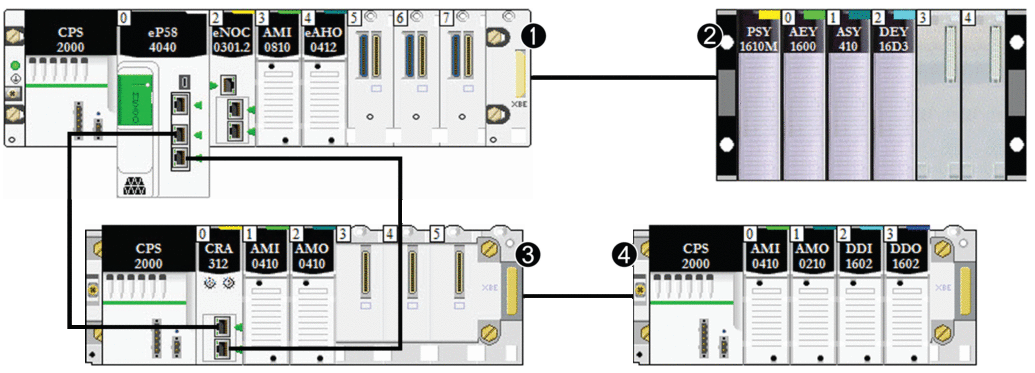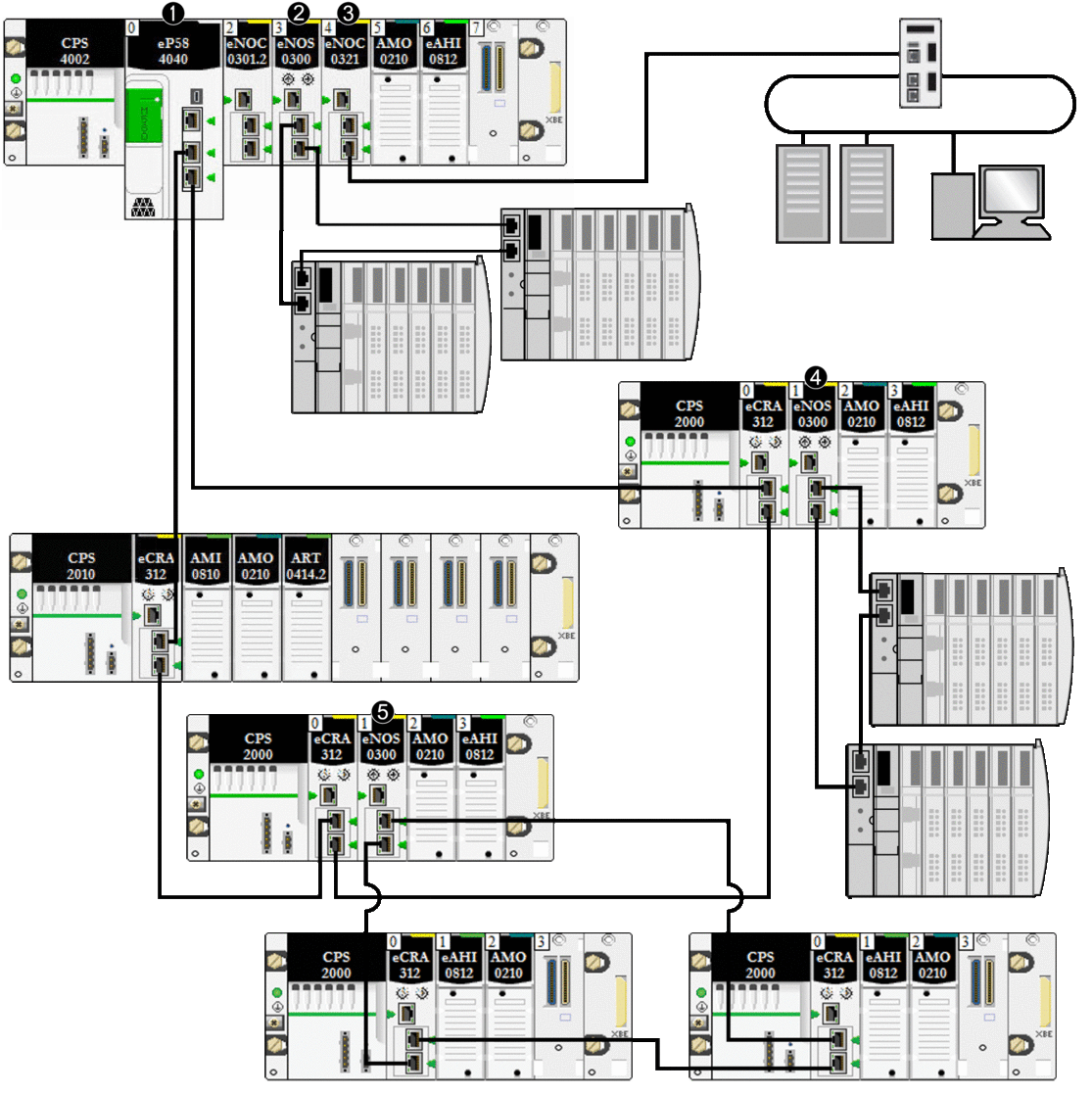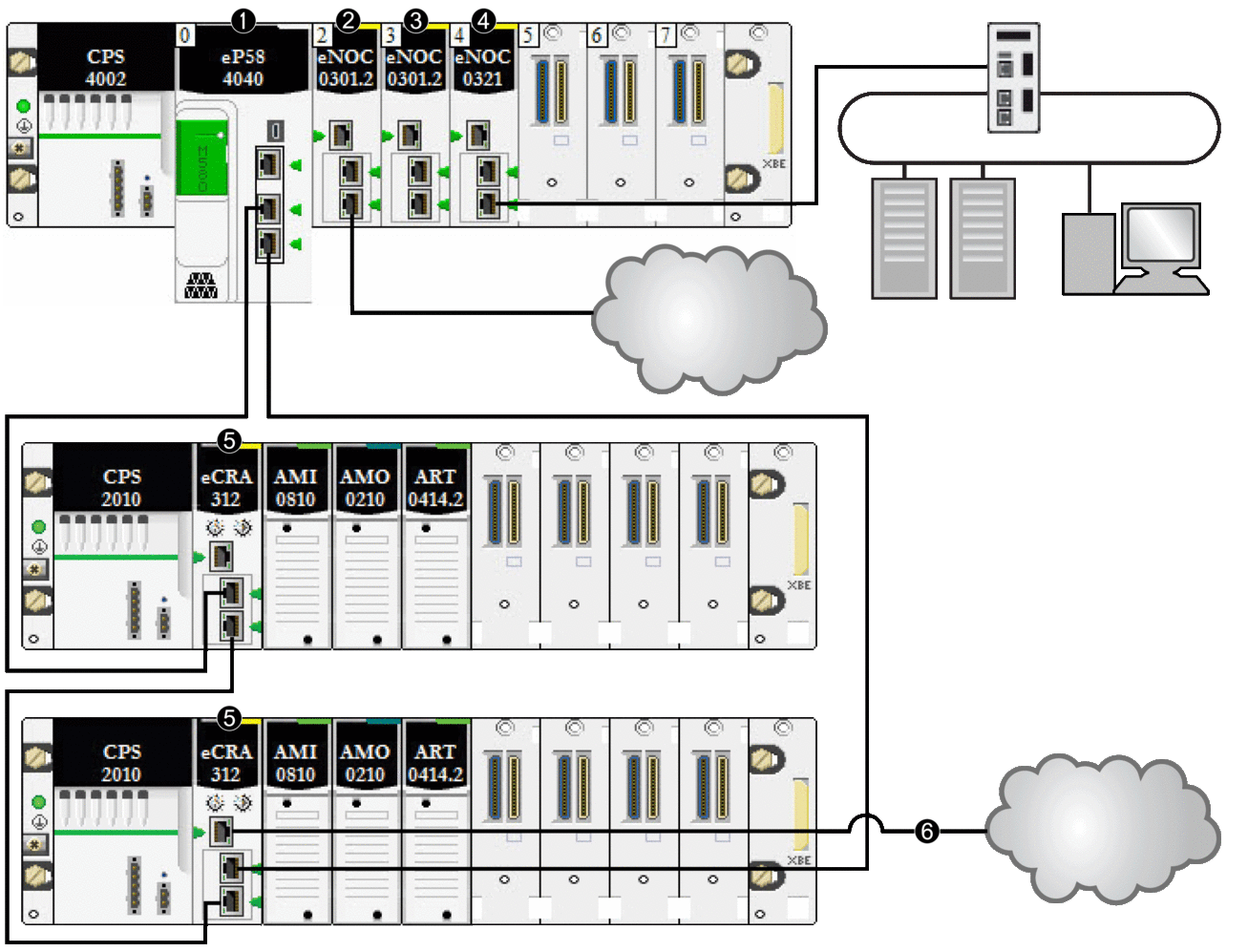Introduction
When you connect the M580 local rack to one or more RIO drops in an M580 system, you establish the RIO main ring.
These are the available physical components for an RIO main ring:
local rack: An M580 local rack contains the CPU and a power supply. The local rack consists of a main rack and sometimes an (optional) extended rack.
RIO drops: RIO drops are M580 racks that include I/O modules that are connected to an Ethernet RIO network. The drops are managed by an Ethernet RIO adapter module. A drop can include a single rack or a main rack plus an (optional) extended rack.
BMENOS0300 network option switch modules.
A typical M580 system also allows you to perform these tasks:
Connect RIO sub-rings to the main ring via BMENOS0300 modules.
Create transparency between the RIO network and the control network via a BMENOC0321 control network module on the local rack.
Connect distributed equipment to the M580 network with these devices:
service port of the CPU
BMENOC0301/BMENOC0311 Ethernet communication module
BMENOS0300 network option switch module
Refer to the M580 System Planning Guide for Complex Topologies to connect distributed equipment with dual-ring switches.
Local Rack
Within the main ring in a typical M580 system, a local rack contains the CPU, a power supply, and a maximum of six Ethernet communication modules, including a maximum of three BMENOC0301/BMENOC0311 modules and BMENOS0300 network option switch modules, and a maximum of two BMENOC0321 control network modules.
A local rack consists of one main rack and up to seven full extended racks (up to 14 Premium half racks), depending on the CPU you use. The main rack is required in the M580 architecture; extended racks are optional, and when present, are considered part of the local rack.
This graphic shows an M580 main local rack with an extended local rack:

The main local rack can be installed on a BMEXBP••00 Ethernet backplane or a BMXXBP••00 X Bus backplane (PV:02 or later).
The extended local racks are either BMXXBP••00 X Bus backplanes or, for Premium I/O, TSXRKY•EX backplanes.
Module/backplane compatibility:
You can install Modicon X80 I/O modules on BMEXBP••00 Ethernet or BMXXBP0•00 X Bus backplanes.
You can install Modicon eX80 (example: PMESWT0100 and BMEAH•0•12 modules) on BMEXBP••00 Ethernet backplanes only.
You can install Modicon eX80 and Modicon X80 modules on BMEXBP••02 backplanes, which support both Ethernet and X Bus communications.
You can install Premium I/O modules on TSXRKY•EX Premium backplanes only.
Backplane compatibility:
Local Racks |
Remote Racks |
|||
|---|---|---|---|---|
Main Rack |
Extended Rack |
Main Rack |
Extended Rack |
|
BMEXBP••00 Ethernet |
X |
— |
X |
— |
BMXXBP0•00 X Bus |
X1 |
X |
X2 |
X |
TSXRKY•EX Premium |
— |
X |
— |
— |
BMEXBP0602(H) Ethernet/X Bus |
X |
— |
X |
— |
BMEXBP1002(H) Ethernet/X Bus |
X |
— |
X |
— |
X: allowed —: not allowed 1 Requires a hardware revision of PV:02 or later. 2 Requires a hardware revision PV:02 or later f you use a BMECRA31210 eX80 performance EIO adapter module. |
||||
BMEXBP••0• backplanes also provide X Bus connections across the backplane, and are therefore compatible with Modicon X80 modules supported by the M580 system. BMXXPB••00 X Bus backplanes, on the other hand, do not have the connections required to support eX80 modules.

1 Ethernet connector
2 X Bus connector
RIO Drops
An RIO drop is connected to an RIO ring. These drops consist of one or two racks of (e)X80 I/O modules and/or third-party modules. An RIO drop is connected to the daisy-chain ring on which the Ethernet RIO network resides. Each remote drop contains one BM•CRA312•0 (e)X80 EIO adapter module. Each rack in a remote drop contains its own power supply module.
RIO drops provide deterministic communication on the main ring and the RIO sub-rings so that RIO modules synchronize with CPU tasks (MAST, FAST, AUX0, AUX1); whereas distributed equipment is not deterministic.
Remote eX80 EIO adapter modules are available as Ethernet (BME) and X Bus (BMX) communicators. If you plan to use X80 I/O modules that require Ethernet, then choose a BME-style X80 EIO adapter module. If your X80 I/O uses only X Bus for backplane communication, then you can use a BMX-style X80 EIO adapter module or a BME-style X80 EIO adapter module.
RIO drops are connected to the main ring via copper cable to the CPU with Ethernet I/O scanner service on the local rack or to another RIO drop (which may be connected to another RIO drop or the CPU).
An RIO drop contains a main remote rack and an optional extended remote rack, depending on the (e)X80 EIO adapter module that is on the RIO drop:
If you install a BM•CRA31200 (e)X80 standard EIO adapter module, extended remote racks are not supported.
If you install a BM•CRA31210 (e)X80 performance EIO adapter module, one extended remote rack is supported.
The adapter module is installed in slot 0 (directly to the right of the power supply) in the main rack of the drop.
A maximum of 31 RIO drops can be supported in an M580 network.
This graphic shows an RIO drop (with a remote extended rack) connected to a local rack (with a local extended rack):

1 local main rack
2 local extended rack
3 remote main rack
4 remote extended rack
Network Option Switch Modules
A BMENOS0300 network option switch module in an M580 network can connect RIO and DIO sub-rings as well as DIO clouds to the RIO main ring. A network option switch module is considered a communication module when you calculate the maximum number of communication modules allowed on a local rack.
Use a BMENOS0300 module for these purposes:
Reduce system costs by using a BMENOS0300 module instead of a dual-ring switch (DRS) to connect RIO and DIO sub-rings to the Ethernet I/O network and instead of a BMENOC0301/BMENOC0311 to connect distributed equipment to the network.
Enable RSTP recovery support for devices and cables on RIO and DIO sub-rings.
Isolate the RIO and DIO sub-rings from one another and from the main ring to improve system robustness.
In this simple device network, a BMENOS0300 network option switch module is installed on the local rack and one of the RIO drops. The BMENOS0300 modules connect DIO sub-rings to the RIO main ring:

1 A CPU with Ethernet I/O scanner service on the local rack is connected to the main ring.
2 A BMENOS0300 module on the local rack connects a DIO sub-ring to the main ring.
3 A BMENOC0321 module on the local rack provides transparency between the device network and the control network.
4 A BMENOS0300 module on an RIO drop connects a DIO sub-ring to the RIO main ring.
5 A BMENOS0300 module on an RIO drop connects an RIO sub-ring to the RIO main ring.
BMENOS0300 modules and BMENOC0301/BMENOC0311 modules differ in these ways:
Service |
BMENOC0301/11 |
BMENOS0300 |
|---|---|---|
Ethernet communication module |
X |
X |
DIO scanner service |
X |
— |
Local rack installation |
X |
X |
RIO drop installation |
— |
X |
FDR service |
X |
— |
Fiber Converter Modules
You can install a BMX NRP 020• fiber converter module on a Modicon X80 rack and Modicon X80 Ethernet RIO drops to convert copper cable to fiber for distances greater than 100 m.
Distributed Equipment
In an M580 system, distributed equipment can communicate with an M580 Ethernet RIO network, or it can be isolated from the network:
Integrating distributed equipment into an Ethernet RIO network: Distributed equipment is connected to the RIO main ring through the service port of a CPU, an Ethernet communication module, or a BM•CRA31210 (e)X80 EIO adapter module on the main ring or sub-ring. (The maximum load the network can process through the connection to the BM•CRA31210 module is 5 Mbps per second.) Special types of distributed equipment that have two Ethernet ports and support RSTP may be connected to the main ring as a DIO sub-ring. Many types of distributed equipment may be connected as DIO clouds.
NOTE: Refer to the DIO clouds topic to see how DIO clouds can be connected to the device network.A BMENOC0301/11 Ethernet communication module scans DIO networks in the M580 device network when its Ethernet backplane connection is enabled, allowing it to communicate with the CPU. Enabling the Ethernet backplane connection links the BMENOC0301/BMENOC0311 module and the CPU network port connections together, allowing either device to manage the distributed equipment.
You can also connect distributed equipment this is part of an existing DIO network as an extended DIO network in an M580 system. Connect a BMENOC0301/BMENOC0311 module to the existing DIO network as well as the extend port of a BMENOC0321 module so that the distributed equipment can communicate with the M580 control network.
Isolating distributed equipment from an Ethernet RIO network: Distributed equipment in DIO clouds can be managed by either a CPU (independent of any RIO network), a BMENOC0301/BMENOC0311 module, or a BMENOS0300 module whose Ethernet backplane connection is disabled, thus not allowing communication between the DIO cloud and the RIO network. These DIO clouds may contain equipment such as TeSys T motor drives, islands of STB devices, SCADA and HMI devices, and PCs. If you use a device that has two Ethernet ports and supports RSTP, you can connect the device in a star or a daisy chain loop. In this instance, the distributed equipment is isolated and is not a physical or logical part of the Ethernet RIO network.
You can also connect distributed equipment that is part of an existing DIO network to the M580 control network only (not the M580 device network). To connect an independent DIO network, connect a BMENOC0301/BMENOC0311 module (with its Ethernet backplane port disabled) to the existing DIO network as well as a BMENOC0321 module. The distributed equipment are not a physical or logical part of the device network, but they do communicate with the M580 control network.
Distributed equipment can be connected to the M580 network via the CPU, BMENOC0301/BMENOC0311, or BMENOS0300 modules on the local rack. Equipment can also be connected to the service port of a BM•CRA31210 X80 performance EIO adapter module. Distributed equipment cannot be connected directly to the RIO main ring. To use a dual-ring switch (DRS) to connect distributed equipment to the M580 network, refer to the M580 System Planning Guide for Complex Topologies.
Example: Advantys STB islands are used as examples of distributed equipment in this document. When an STB island is used with an STB NIP 2311 EtherNet/IP network interface module (NIM), the island can be connected directly to an Ethernet port of a BMENOC0301/BMENOC0311 communication module, the service port of a BM•CRA312•0 eX80 EIO adapter module, a BMENOS0300 network option switch module, or the service port of an M580 CPU in a daisy chain formation. The STB NIP 2311 NIM has two Ethernet ports and it supports RSTP, enabling it to operate as a ring connected to the two Ethernet ports on a communication module:

1 STBNIP2311 NIM
2 STBPDT3100 (24 Vdc power distribution module)
3 STBDDI3230 24 Vdc (2-channel digital input module)
4 STBDDO3200 24 Vdc (2-channel digital output module)
5 STBDDI3420 24 Vdc (4-channel digital input module)
6 STBDDO3410 24 Vdc (4-channel digital output module)
7 STBDDI3610 24 Vdc (6-channel digital input module)
8 STBDDO3600 24 Vdc (6-channel digital output module)
9 STBAVI1270 +/-10 Vdc (2-channel analog input module)
10 STBAVO1250 +/-10 Vdc (2-channel analog output module)
11 STBXMP1100 (island bus termination plate)
DIO Clouds
A DIO cloud contains distributed equipment that may support RSTP. DIO clouds require only a single (non-ring) copper wire connection. Connect a DIO cloud directly to one of these:
BMENOS0300 network option switch module
BMENOC0301/BMENOC0311 Ethernet communication module
service port of the CPU
service port of a BM•CRA312•0 eX80 EIO adapter module on an RIO drop
Distributed equipment in a DIO cloud communicates with the M580 network through a connection to the main ring:

1 A CPU on the main rack runs the Ethernet I/O scanner service.
2 A DIO cloud is connected to a BMENOC0301/11 Ethernet communication module (Ethernet backplane connection disabled).
3 A BMENOC0301/BMENOC0311 Ethernet communication module (Ethernet backplane connection enabled) manages distributed equipment on the device network.
4 A BMENOC0321 module on the local rack provides transparency between the device network and the control network.
5 An X80 performance EIO adapter module connects an RIO drop to the main ring.
6 A DIO cloud is connected to a BM•CRA31210 X80 performance EIO adapter module.
When a DIO cloud is connected directly to a BMENOC0301/BMENOC0311 or a BMENOS0300 module (with the Ethernet backplane port disabled), distributed equipment is isolated from the RIO network because it does not communicate with the CPU Ethernet I/O scanner service:

1 CPU with DIO scanner service
2 BMENOC0301/BMENOC0311 Ethernet communication module (Ethernet backplane connection disabled)
3 DIO isolated cloud
Device Network
A device network is an Ethernet RIO network where distributed equipment can participate with RIO modules.
In this type of network, RIO traffic has the highest priority on the network, so it is delivered ahead of DIO traffic, providing deterministic RIO exchanges.
The device network contains a local rack, RIO drops, distributed equipment, network option switch modules, adapter class devices, etc. Devices connected to this network follow certain rules to provide RIO determinism. Details about determinism are provided in the discussion of application response time.
Control Network
A control network is an Ethernet-based network that contains PACs, SCADA systems, an NTP server, PCs, AMS system, switches, etc. Two kinds of topologies are supported:
flat: All devices in this network belong to the same subnet.
2 levels: The network is split into an operation network and an inter-controller network. These two networks can be physically independent, but are generally linked by a routing device.
The BMENOC0321 control network module is installed on the local rack of an M580 system. The module provides the interfaces to communicate with a control network and client applications on an Ethernet RIO network.
The main purpose of the BMENOC0321 module is to provide transparency between the control network, the device network, and an extended DIO network, while preserving device network determinism. In addition, the BMENOC0321 module provides services to communicate with PAC applications running on the control network.
Only one BMENOC0321 module can be configured on the local rack. To communicate with modules in an M580 device network, confirm that the Ethernet backplane ports of the CPU, BMENOC0301/BMENOC0311 modules, and the BMENOC0321 module are enabled.
Copper and Fiber Cables
Copper and fiber cable types and maximum distances for RIO modules are discussed in the cable installation topic in the Modicon M580 Remote I/O Modules Installation & Configuration Guide.
Calculating Maximum Devices in a Typical M580 Main RIO Ring
The main ring in a typical M580 system supports up to 32 devices. These are the valid types of devices:
a local rack (containing the CPU, communication modules and I/O modules)
a maximum of 31 RIO drops (each drop containing a BM•CRA312•0 EIO adapter module)
Do not count BMXNRP020• modules in your calculation.
The maximum number of BM•CRA312•0 EIO adapter modules in an RIO network is 31.
For the maximum number of modules supported in an M580 system, refer to the communication capability topic and the throughput considerations topic.


